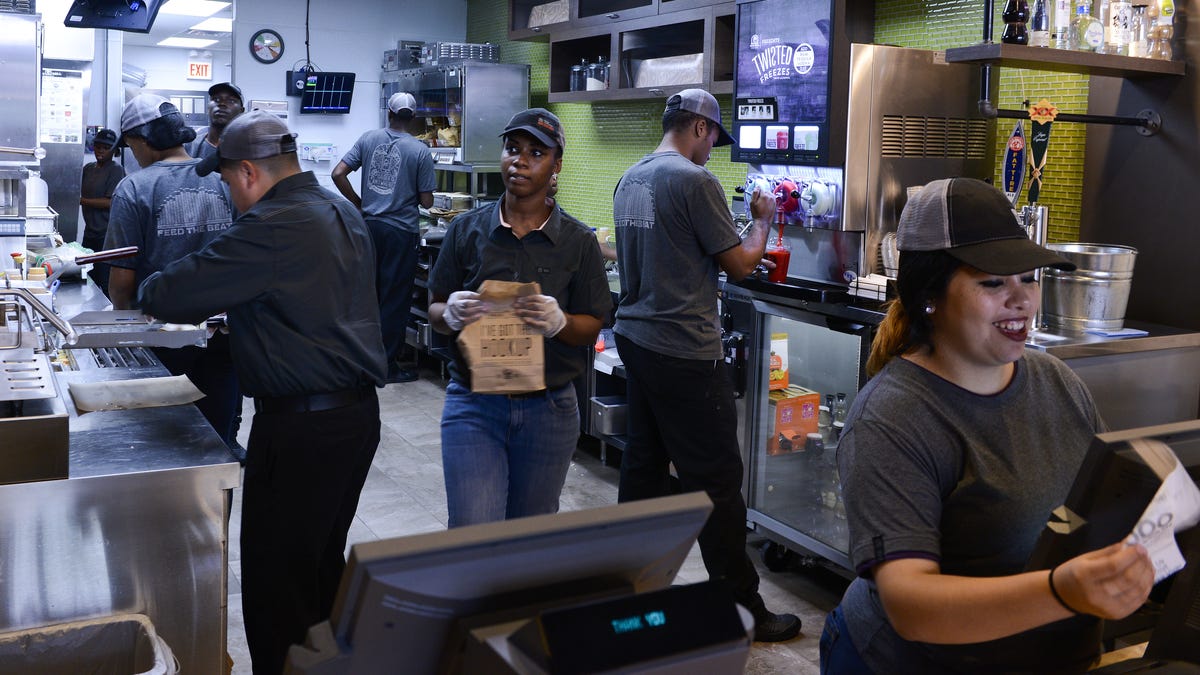LATEST FINANCIAL NEWS
‘There were six. And now there’s zero’: Restaurant industry grapples with lack of diversity in executive ranks
Steven Davis, former CEO of Bob EvansThis is not a one-year exercise. They need a five-year plan because they have to build a pipeline to train and recruit. They’re going to have to roll up their sleeves and do the work.”This is not a one-year exercise. They need a five-year plan because they have to build a pipeline to train and recruit, ” says Steven Davis, who was chairman and CEO of Bob Evans Farms from 2006 to 2014 and is African American. “They’re going to have to roll up their sleeves and do the work.”Half of the hourly workers in restaurants are people of color according to a 2014 report co-sponsored by the Multicultural Foodservice & Hospitality Alliance (MFHA), a nonprofit affiliate of the National Restaurant Association.Yet only 31% of general managers in charge of a restaurant are non-white. And at the highest levels, just 10% of board members and 8% of corporate executives are people of color.Meanwhile 52% of hourly restaurant workers are women, while they make up just 29% of restaurant general managers, says the MFHA. Among corporate directors, 31% are female, while women are 23% of executives and hold 17% of seats on company boards. Rising in management can have a real impact on how much an employee earns, and how much wealth they may be able to build.Fast food and counter workers make an annual mean wage of $24,540, while food service managers for restaurants earn a mean wage of $57,820 and top executives in accommodation and food services have a mean yearly salary of $85,830 according to May 2020 data from the Bureau of Labor Statistics.Food services is hardly the only industry to lack diversity in its executive ranks. Barriers to advancement exist throughout corporate America, with people of color and women often held to higher standards for promotion than their white and male peers, while being largely outside the networking circles decision-makers typically tap for talent, experts and business leaders say.Across industries, only 3% of C-Suite leaders were women of color in 2020 as compared to 19% who were white women, according to a study conducted by McKinsey & Company in partnership with LeanIn.org. Men of color comprised 12% of those in the C-Suite, as compared to 66% of such leaders who were white men. But the lack of diversity among restaurant executives is striking given the disproportionate representation of people of color in lower-level positions and the multicultural customer base the industry serves, advocates and corporate leaders say. “If there was ever an industry where there should be more diversity in the board room and C-Suite,” it’s restaurants, says White.In recent years, restaurant companies have also been the frequent target of activist investors who push for cost cuts and other changes to boost a company’s stock price. Their campaigns can result in the ouster or exit of a company’s CEO, and when those top executives are Black or female, they’ve typically been replaced by a white man, research shows. Since 2011, campaigns by activist investors led to the exit of 28 chief executives who were at the helm of public restaurant companies, according to the investment firm Mill Road Capital, citing research by Capital IQ.Of those departed corporate leaders, 11 were women or people of color. And white men were selected to fill 27 of those 28 CEO vacancies. “It’s just a closed system,” says White, Mill Road Capital managing director, regarding the replacement of top executives after activist campaigns. “It’s who I know and who I’m comfortable with. So whether conscious or unconscious, the ultimate result is a less diverse leadership in the restaurant space.” James D. White, former CEO of Jamba Juice, was one of six Black CEOs of public restaurant companies, the most ever for the industry.James WhiteYet, having a diverse group of executives can bolster the bottom line. In 2019, businesses that ranked in the top quartile for ethnic diversity among their executives were 36% more likely to have higher than average profits than businesses that were the least inclusive according to a global report by McKinsey & Company. Businesses with the most women among their top leadership were 25% more likely to have higher profits than those businesses that had the least.”The most diverse companies are now more likely than ever to outperform less diverse peers on profitability,” the report said. But while some companies have been very focused on inclusion, “most have made little or no progress, and some have even gone backward.” McKinsey noted it would be a mistake for businesses to use the pandemic as an excuse to put off diversity efforts. “Companies whose leaders welcome diverse talents and include multiple perspectives are likely to emerge from the crisis stronger,” the company wrote..”Voices that represent an array of experiences are also critical to speaking to and serving the multicultural workforce and consumer base in the U.S., industry insiders and observers say. “If you’re creating an item that’s tone-deaf or not meeting the needs of the demographic you’re targeting … that can be a costly mistake,” says Jan of Cornell. “The more input you have on a conversation that could potentially go awry or be misunderstood, the better chance you have of getting that message across the right way the first time.’’Lilly Jan, who teaches food and beverage management at Cornell’s School of Hotel AdministrationIf you’re creating an item that’s tone-deaf or not meeting the needs of the demographic you’re targeting … that can be a costly mistake.Jan recalled a 2012 advertising campaign for Pop Chips featuring actor Ashton Kutcher who appeared in brown face and spoke in what was supposed to be an “Indian” accent. Though it’s not clear who signed off on the messaging, “I would like to think that had there been someone of color involved, they would have spoken up and suggested they pursue an alternative ad,” Jan says. Additionally, as the economy reopens and the restaurant industry struggles to hire workers, a clear commitment to improving diversity could help companies hold onto employees. Businesses that had a corporate strategy to foster more inclusion had a turnover rate among hourly workers that was 17% lower than businesses that did not, according to the MFHA report. In business terms, that translated into saving the $700 it costs on average to replace one hourly worker and the roughly $11,000 typically spent to hire a new manager, according to People Report, MFHA’s survey partner. “Money is a short-term motivator,” Jan says. “If people can see a path for their own career growth with an organization, they’re more likely to stay.” But people of color are more often found in the lower tiers of management, says Gerry Fernandez, president of the MFHA.Employees prepare food at the new Taco Bell Cantina restaurant on Sept. 22, 2015, in Chicago, Ill.Matt Marton, APThere are African American and Latino general managers, for instance, “but they don’t go to the next level,” such as becoming a director of operations which allows them to demonstrate they can hit sales numbers, manage costs and manage people, Fernandez says.Mentors and sponsors are also key. “If you haven’t been planting seeds with young talent and saying ‘I can see you as director and vice president,’ you can’t turn around and find the (vice presidents) you need who can take on bigger roles of responsibility,” Fernandez says.When Cris Cardona, 21, got a job at a McDonald’s in Orlando, Florida, three years ago, he started out as a crew member. A year later, he was promoted to shift manager.But Cardona says when it comes to management, “there’s two layers … Anything above general manager, there tends to not be a lot of people of color.’’Cardona, who is Latino, says he once might have sought a higher management role. But he’s now lost interest. “In the age of COVID, it’s very tough,’’ he says. In addition to being understaffed, “customers are difficult … They don’t really care about the workers. They don’t wear their masks.’’It’s also been hard to imagine himself higher on the corporate ladder when he sees few people who look like him at the top. But he believes more diverse leadership could significantly impact the lives of the women and people of color who dominate the industry’s front lines.“They might understand why (workers) need a living wage,’’ he says of executives with more varied life experiences and perspectives. “There’s not a lot of female upper managers (but) they might understand more why they need paid maternity leave … If there’s only men at the top, they’re not going to relate.’’Less than 2% of top executives at the 50 largest companies are BlackCompanies across the country have been speaking out against racism, but less than 2% of top executives at 50 largest companies are Black.USA TODAYIn February, McDonalds’s announced that starting this year, it will link improving diverse representation among the company’s leadership to annual incentive compensation for executive vice-presidents.In four years, the company said it expects to boost the number of people from underrepresented groups who are senior directors or higher to 35% from 29% in the U.S. The number of women in those senior roles is expected to rise to 45% from 37% in that time frame, and McDonald’s aims to have gender parity before 2031. “We will accept nothing less than real, measurable progress in our efforts to lead with empathy, treat people with dignity and respect, and seek out diverse points of view to drive better decision-making,” Chris Kempczinski, McDonald’s president and CEO said in a statement at the time. Meanwhile, Yum! Brands, which includes KFC, Taco Bell and Pizza Hut, announced last month that it’s part of the OneTen Coalition, a group of U.S. companies that pledge to train and promote one million Black Americans over the next decade with a particular focus on those who do not have a four-year degree.Yum!’s U.S. brands will aim first to diversify the general managers and field leaders for company-owned restaurants, as well as positions in Yum!’s corporate offices. The effort dovetails with Yum!’s global initiative, kicked off last year, that is focused on raising the number of people of color and women who are executives, managers, franchisees and suppliers.“We’re stronger when we have diverse people, voices and ideas at the table,” James Fripp, Yum! Brands chief equity and inclusion officer said in an emailed statement.James Fripp, Yum! Brands chief equity and inclusion officerWe’re stronger when we have diverse people, voices and ideas at the table.Mill Road Capital has started the Progressive Governance Fund, an investment fund for small publicly traded companies, and pledges that at least 50% of the candidates it nominates to those businesses’ boards of directors will be women or people of color.And the MFHA is also working with the National Restaurant Association and an advisory group made up of the industry’s African American former CEOs on a range of initiatives to increase the number of Black food service business owners and franchisees, as well as people of color on boards and in the executive ranks.Hitting inclusion benchmarks should be as key to the assessment of an executive’s performance as sales goals, says Davis, who, when he helmed Bob Evans, saw the company’s stock price grow 96% and equal or exceed the performance of its peer restaurants.”Business executives are paid to strategize and execute,” he says, “so they should have some metrics around making improvements.That could lead to lasting change. “We now need to go from reflection to action,” says Davis who is currently a consultant and member of several boards. “Many of my peers have said ‘We’ve been here before. What’s going to be different?’ If it’s going to be different, it has to be sustained. We can’t backtrack.”Follow Charisse Jones on Twitter @charissejonesStories like this are possible because of our subscribers like you. Your support will allow us to continue to produce quality journalism.Stay up to date by signing up for one of our newsletters.Sign upPublished
4:06 am UTC May. 14, 2021
Updated
4:06 am UTC May. 14, 2021
Source link









